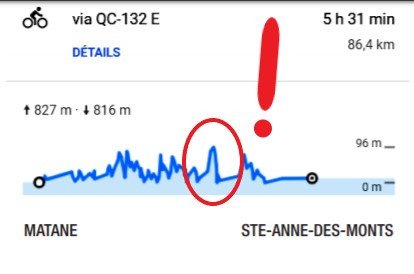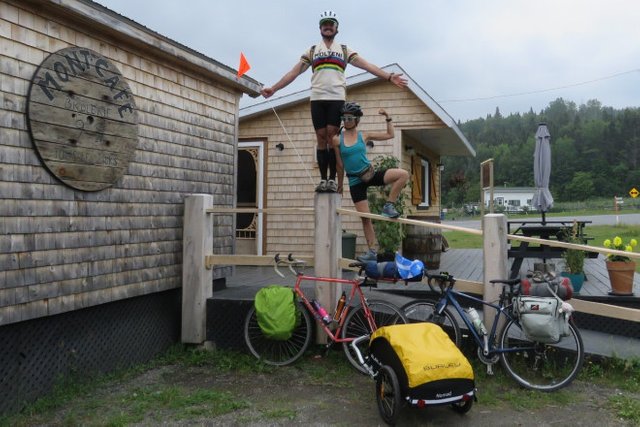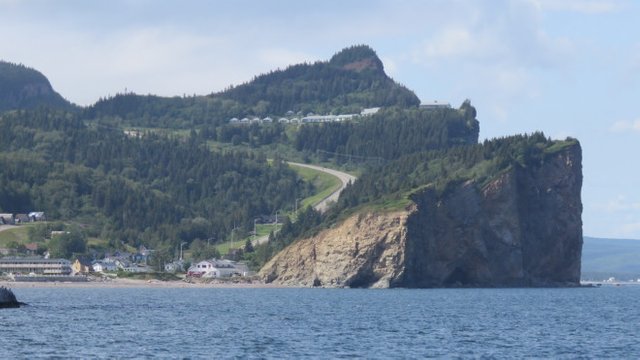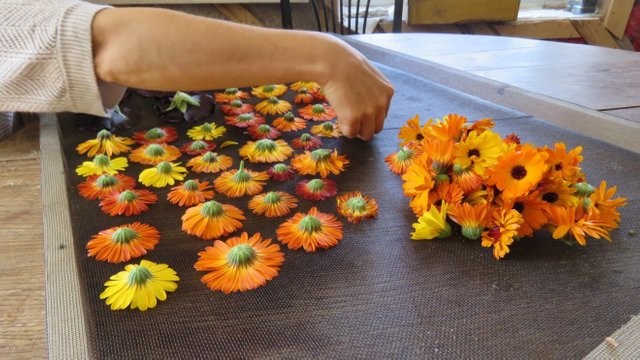
Written by Thumbs. Originally published on November 11, 2019 at communelifeblog

A RURAL PENINSULA IN QUEBEC IS A HIDDEN GEM OF THE COMMUNITIES MOVEMENT
Gaspésie Quebec is the Olympic Peninsula of the East Coast; a mountainous peninsula, with a rugged coastline, spotted with small towns fueled by fishing and logging, with a vibrant indigenous culture, all woven together with bicycle friendly roads. However, as a couple of community hummingbirds what we were most allured by was the growing intentional community network around this vibrant peninsula. The best part is that they are all connected by one of the most popular scenic bicycle touring routes in Quebec. We packed our paniers, clipped in and started pedaling a 700km tour of ravishing natural beauty and inspiring community projects.

My partner’s annotation of the elevation map of the Gaspésie captures the intensity of the trip
We started our tour at Hameau 18 (Hamlet 18) on the shores of the St. Laurence in Cap-au-Renard. When we rolled in it felt like walking into a story book of community life. The pizza oven was radiating heat into the outdoor kitchen, where people were bustling back and forth from the summer gazebo with its reciprocating living roof and full round timber frame. The pizza was still cooking so in a baffled state of awe we kept walking towards a couple performing acroyoga with the backdrop of a setting sun. The scene enraptured our gaze for only a moment though, because we were eagerly handed a glass of freshly brewed raspberry juice and invited to take a couple mallet swings at the newly minted blacksmith forge. Once we sat down for pizza, I felt at peace to feel so at home, yet so in awe.
Hameau 18 is a manifestation of a community dream I’ve heard many groups aspire to, but few actually create such a vibrant example of. It’s the dream of synergizing community life and sustainable business incubator. It started 12 years ago with 5 friends buying a lease for the land. Through a Kickstarter and low interest loans from friends, they paid off the mortgage and sold it to a Cooperative each member now owns a share in. The 55 hectares they own are convenient for a Cooperative CSA a couple of the members run, fertile enough for a 10 acre farm, along a major road to support a local roaster cafe, near the ocean to support an algae farming business, and a short commute to town for a local doctor to live. Each of the members is tenaciously self-driven (most building their own house as well as running their own business) and loves the rugged life of coastal Gaspésie (average temperature 0 C) yet wouldn’t go it alone.
The way Hameau 18 is navigating personal homes is a telling example for the challenges of negotiating personal autonomy and community support. As a natural builder I was enthralled with each of the homes there, because they were a colorful mix of techniques yet each was functional to the high bar their climate demands (I saw straw bale with reclaimed windows, reciprocating living roofs with children running on top, locally milled log cabin, and platform mounted four season family yurt). This extraordinary level of innovation and competence came at the cost of high out of pocket expenses for each member, and long build times due partially to limited help. Members must personally finance the building of their home, and there isn’t a culture of “barn raising” a member’s home, so they must also budget for the time and energy it will take them to build on their own. After it is built, the Hameau 18 Cooperative will buy it back from them over the course of years until it becomes cooperatively owned asset. Some members are interested in creating zero interest loans for members to help kickstart their home building process, but for now taking on the task of building your dream home is equal parts liberating and daunting.

Preparing for lift off at the cafe that a couple of Hameau 18 members run
With our bicycle trailer packed and my French lesson audiobook playing we hit the road for the daunting next 220 km of our ride. Collectively I’ve enjoyed a few thousand kilometers on bicycle tour often crossing large mountain ranges, yet the Gaspésie route boasts a mere 533m as the highest point in 700km of riding, so I wasn’t quivering at the challenge. However, what my always sunny perspective had overlooked was that this 100-year-old road isn’t graded like a typical highway, but instead hugs the cliffs of the coastline with unforgiving linearity. My beloved travel partner captured the intensity of these days best by circling sections of the elevation map where we appeared to be either climbing straight up a cliff side, or in free fall. Luckily the drivers in Gaspésie were the most respectful ones I’ve ever experienced, often stopping traffic to wait for the right time to pass and giving us honks and fist pumps when we were wavering most on the vertical climbs.

This 17% grade hill is the closest we came to free fall!
Our next stop wasn’t at a community, but at the second home of a pair of community builders on sabbatical. In exchange for not telling you who they are or what community they are associated with I can share more honest stories from the frontier of community founding.
After spending years starting a community, they were taking a year off, without commitments to return. Right off the bat this struck me as a profoundly humble move, which should be built into the community start-up guide. Founder syndrome sounds terribly clinical yet is such a multi-dimensional challenge for communities it’s hard to cure it with protocols. This sabbatical was a surefire technique to let the vision of the community grow its own identity separate from the vision of a few founders. By stepping away from all meetings and voting influence right as the community was becoming a self-sustaining organism, these founders were essentially parents trusting their kid would find its way and be more resilient without their tutelage.
What I learned from them was that in starting a community you can lose yourself. Starting a community isn’t compatible with also pursuing a highly specialized independent life. Instead, a founder must immerse themselves in the myriad of head, heart and hand skills for building the foundation of community and let wither personal projects unrelated to the vision. Yet there is also another phase, after a community has built a strong foundation in which another wave of equally passionate, but potentially more specialized communards can flourish. Once the community has systems to sustain itself, members can have free time to pursue their individual passions or integrate their passions into the community. It’s like a baby who in the first years of life is simply growing, and figuring out how to stay alive, but later in life one has the necessities of life figured out and can integrate more unique passions into their daily life. My hypothesis is that the length of this baby phase is directly related to the degree of income, resource, and responsibility sharing, with fully interdependent communes spending the longest time in diapers.
Fast forward through a boat trip, island hike, Gannet colony, and we arrive at the only commune in Quebec, Le Manoir! We rolled in just as the Beat Rave (Anglo-French pun) was beginning, which is like entering a movie theatre during the climax of the story arch. Nachos came pouring out of the oven, home brewed beer and fresh cocktails served generously, and we danced swing until our bodies reminded us of the 90km straight into headwind we’d bike all day and we collapsed in our tent.
Le Manoir is a like a sapling whose tap root is just reaching the aquifer, it has had enough member turnover, by laws tested in the real world, and steady flow of profitable community business that I think it’s going to become a sustaining community for at least the next decade. Its founders Audrey and Arielle traveled communes around the US for a couple years and integrated what they learned into the culture and economy of Quebec. With only 6 adult members, they are at the fledgling stages of their community vision to create a Twin Oaks size community, but they are currently doubling the size of their main house (le manoir) and have endless potential on their expansive property.

Preparing Calendula flowers for drying at Le Manoir
Like Hameau 18 they are comprised of economically self-sustaining individuals, but Le Manoir shares the income of every members endeavor and has a community labor quota for some businesses (including the farm and herbal apothecary). With 40hrs a week of community labor required, communal lunches and dinners, and one common house it feels familiar to some other FEC communities. Seeing this framework for community flourish in another country gave me hope that the trials and tribulations we each face in building our communities aren’t just to serve ourselves but can be part of an international community movement which doesn’t homogenize but creates a baseline each culture can customize. We left Le Manoir with the peace of mind that we’d return or see them at our favorite communities in the States again.
Oh, dear Gaspésie you have stolen my heart, and taken my life vision in a whole new direction. With huge swaths of uninhabited natured, skirted with pockets of small towns where the next generation of intentional communities are taking root you are balancing at the sweet spot between wild lands and culture hubs. I hear that your frigid winters, when the snow is stacked so high the first floor of houses become igloos, is an even more astonishing time of the year. So, I’ll see you again this Winter, and we will see where the story goes next.
____________________________________________________________________________
Thanks for reading! This post was made possible by our patrons on Patreon. The Commune Life team works hard to bring you these stories about our lives in community, and that work couldn’t happen without support from our audience. So if you liked this article, and want to help us make more like it, head on over to https://www.patreon.com/communelife to join us!
Deep gratitude to all of our patrons:
Communities
- Acorn Community
- Compersia Community
- East Brook Community Farm
- The Federation of Egalitarian Communities
- Twin Oaks Community
Communards
- Aaron Michels
- Brenda Thompson
- Cathy Loyd
- Em Stiles
- Jenn Morgan
- Jonathan Thaler
- Julia Elizabeth Evans
- Kai Koru
- Kathleen Brooks
- Laurel Baez
- Lynette Shaw
- Magda schonfeld
- Michael Hobson
- Nance & Jack Williford
- Peter Chinman
- Sumner Nichols
- Tobin Moore
- Warren Kunce
- William Croft
- William Kadish
Thanks!
Posted from my blog with SteemPress : https://www.ic.org/discovering-communities-quebec-bicycle/
very nice
@fatema12
Downvoting a post can decrease pending rewards and make it less visible. Common reasons:
Submit